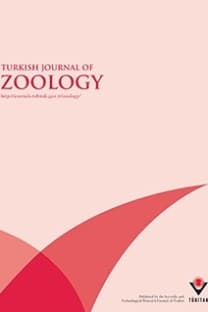Status and distribution of the Striped Hyaena, Hyaena hyaena, in Turkey: an updated assessment (Carnivora: Mammalia)
Status and distribution of the Striped Hyaena, Hyaena hyaena, in Turkey: an updated assessment (Carnivora: Mammalia)
___
- Akarsu F (2014). Şanlıurfa İli Çizgili Sırtlan (Hyaena hyaena) Tür Eylem Planı [Action Plan for the Striped Hyaena in Urfa Province]. Şanlıurfa, Turkey: T.C. Orman ve Su İşleri Bakanlığı, Doğa Koruma ve Milli Parklar Genel Müdürlüğü, XV. Bölge Müdürlüğü, Şanlıurfa Şube Müdürlüğü (in Turkish).
- Akay AE, Inac S, Yıldırım IC (2011). Monitoring the local distribution of Striped Hyaenas (Hyaena hyaena L.) in the Eastern Mediterranean Region of Turkey (Hatay) by using GIS and remote sensing technologies. Environmental Monitoring and Assessment 181: 445-455.
- Akbaba B, Ayaş Z (2012). Camera trap study on inventory and daily activity patterns of large mammals in a mixed forest in northwestern Turkey. Mammalia 76: 43-48.
- Albayrak T, Giannatos G, Kabasakal B. (2012). Carnivore and ungulate populations in the Beydağları Mountains (Antalya, Turkey): border region between Asia and Europe. Polish Journal of Ecology 60: 419-428.
- Çoğal M, Unal M, Öktem İM, Sözen M (2016). A Preliminary study to determine distribution and ecology of striped hyaena (Hyaena hyaena) in the area between Hassa and Reyhanli (Hatay). Nature and Man 194: 24-37 (in Turkish with an abstract in English).
- Çoğal M, Sözen M (2017). The status and distribution of Gazella gazella (Artiodactyla: Mammalia), and other mammals of the Hatay Province in southern Turkey. Israel Journal of Ecology an Evolution 63: 44-49.
- Çoğal M, Ünal M, Sözen M (2017). Hatay bölgesindeki çizgili sırtlanın (Hyaena hyaena) ekolojik özelliklerinin belirlenmesi. Nature and Man 51 (19): 25-30 (in Turkish with an abstract in English).
- Giannatos G, Albayrak T, Erdoğan A (2006). Status of the Caracal in protected areas in south-western Turkey. Cat News 45: 23-24.
- İlemin Y (2014). A camera trapping survey reveals a melanistic Grey Wolf (Canis lupus) in an unusual habitat in Turkey (Mammalia: Carnivora). Zoology in the Middle East 60: 1-5.
- İlemin Y, Gürkan B (2010). Status and activity patterns of the Caracal, Caracal caracal (Schreber, 1776), in Datça and Bozburun Peninsulas, Southwestern Turkey. Zoology in the Middle East 50: 3-10.
- İlemin Y (2017). Marmaris ve Köyceğiz Karakulak Caracal caracal (Schreber, 1776) populasyonunun bazı ekolojik özellikleri, PhD, University of Muğla Sıtkı Koçman, Muğla, Turkey. (in Turkish)
- Kasparek M, Kasparek A, Gözcelioğlu, B, Çolak E, Yiğit N (2004) On the status and distribution of the Striped hyaena, Hyaena hyaena, in Turkey. Zoology in the Middle East 33: 93-108.
- Kelly M, Holub E (2008). Camera trapping of carnivores: trap success among camera types and across species, and habitat selection by species, on Salt Pond Mountain, Giles County, Virginia. North Eastern Naturalist 15: 249-262.
- Kruuk H (1976). Feeding and social behaviour of the Striped hyaena (Hyaena vulgaris Desmarest). East African Wildlife Journal 14: 91-111.
- Meserve RI (2012). Striped Hyenas and ‘Were-Hyenas’ In Central Eurasia. In Allsen et al. Ar-chivum Eurasiae Medii Aevi. Harrassowitz Verlag Wiesbaden.
- Sanderson GJ (2004). Tropical Ecology, Assessment and Monitoring Initiative. Camera photo-Trapping Monitoring Protocol. Washington D.C., USA: The Center for Applied Biodiversity Science, Conservation International.
- Silver SC, Ostro LE, Marsh LK, Maffei L, Noss AJ et al. (2004). The use of camera traps for estimating jaguar Panthera onca abundance and density using capture ⁄ recapture analysis. Oryx 38: 148-154.
- Soyumert A, Tavşanoğlu Ç, Macar O, Kaynaş BY, Gürkan B (2010). Presence of large and medium- sized mammals in a burned pine forest in Soutwestern Turkey. Hystrix The Italian Journal of Mammalogy 21: 97-102
- ISSN: 1300-0179
- Yayın Aralığı: 6
- Yayıncı: TÜBİTAK
Dasi ONG, Shahriza SHAHRUDİN, Mohd Nazri ISMAİL
Diversity of bats in three selected forest types in Peninsular Malaysia
Nursyereen Mohd NASİR, Dzulhelmi Muhammad NASİR, Rosli RAMLİ
Nazan UZUM, Nurhayat OZDEMİR, Cantekin DURSUN, Bilal KUTRUP, Serkan GUL
Nursyereen Mohd NASİR, Dzulhelmi Muhammad NASİR, Rosli RAMLİ
Muhsin COGAL, Yasin ILEMİN, Mustafa SOZEN
Yasin İLEMİN, Mühsin ÇOĞAL, Mustafa SÖZEN
Derya CETİNTURK, Nuri YİGİT, Ercument COLAK, Georgi MARKOV, Dusko CİROVİC, Mihaly MARTON
